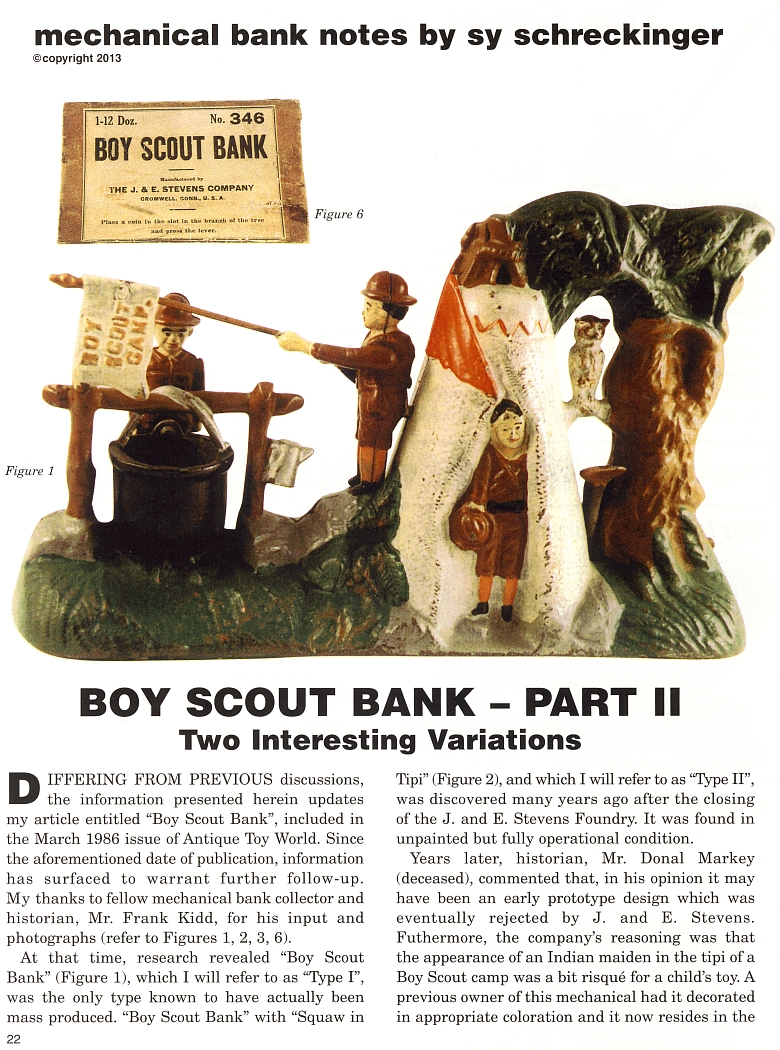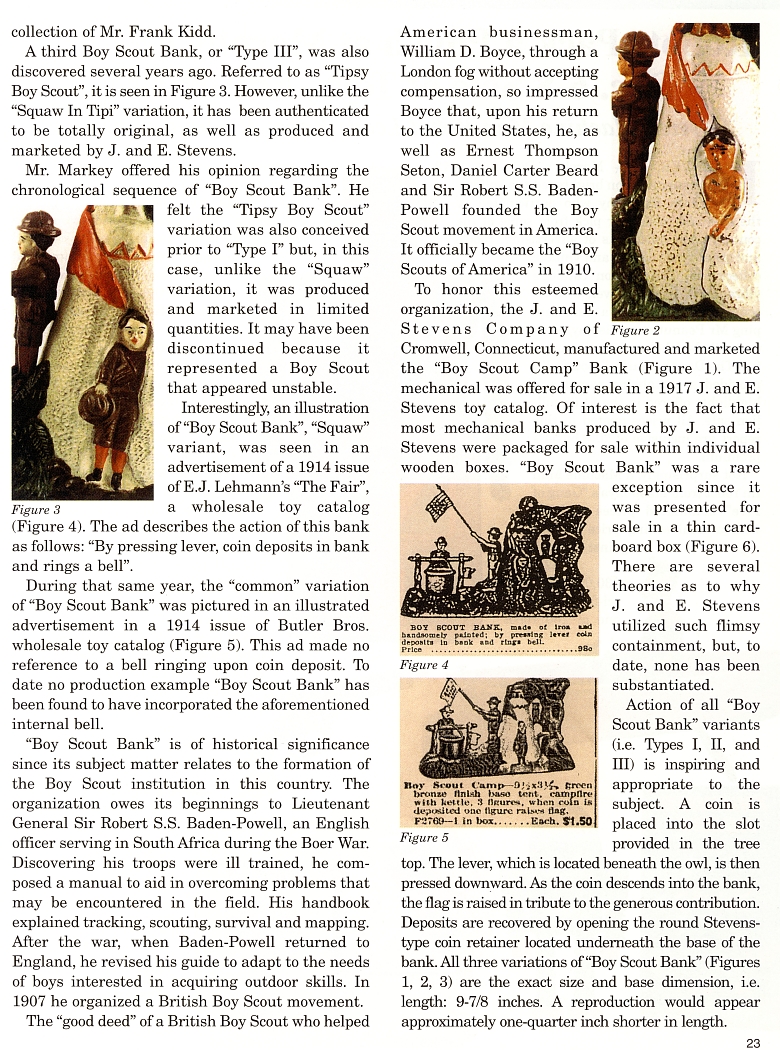|
BOY SCOUT BANK PART II
Two Interesting Variations
by Sy Schreckinger – ANTIQUE TOY WORLD Magazine –
May, 2013
DIFFERING
FROM PREVIOUS discussions, the information presented herein updates my
article entitled "Boy Scout Bank", included in the March 1986 issue of
Antique Toy World. Since the aforementioned date of publication,
information has surfaced to warrant further follow-up. My thanks to
fellow mechanical bank collector and historian, Mr. Frank Kidd, for his
input and photographs (refer to Figures 1, 2, 3, 6).
At that time, research revealed "Boy Scout Bank" (Figure 1), which
I will refer to as "Type I", was the only type known to have actually
been mass produced. "Boy Scout Bank" with "Squaw in Tipi" (Figure 2),
and which I will refer to as "Type II", was discovered many years ago
after the closing of the J. and E. Stevens Foundry. It was found in
unpainted but fully operational condition.
Years later, historian, Mr. Donal Markey (deceased), commented
that, in his opinion it may have been an early prototype design which
was eventually rejected by J. and E. Stevens. Furthermore, the company's
reasoning was that the appearance of an Indian maiden in the tipi of a
Boy Scout camp was a bit risque for a child's toy. A previous owner of
this mechanical had it decorated in appropriate coloration and it now
resides in the collection of Mr. Frank Kidd.
A third Boy Scout Bank, or "Type III", was also discovered several
years ago. Referred to as "Tipsy Boy Scout", it is seen in Figure 3.
However, unlike the "Squaw In Tipi" variation, it has been authenticated
to be totally original, as well as produced and marketed by J. and E.
Stevens.
Mr. Markey offered his opinion regarding the chronological sequence
of "Boy Scout Bank". He felt the "Tipsy Boy Scout" variation was also
conceived prior to "Type I" but, in this case, unlike the "Squaw"
variation, it was produced and marketed in limited quantities. It may
have been discontinued because it represented a Boy Scout that appeared
unstable.
Interestingly, an illustration of "Boy Scout Bank", "Squaw"
variant, was seen in an advertisement of a 1914 issue of E.J. Lehmann's
"The Fair", Figure 3 a wholesale toy catalog (Figure 4). The ad
describes the action of this bank as follows: "By pressing lever, coin
deposits in bank and rings a bell".
During that same year, the "common" variation of "Boy Scout Bank"
was pictured in an illustrated advertisement in a 1914 issue of Butler
Bros. wholesale toy catalog (Figure 5). This ad made no reference to a
bell ringing upon coin deposit. To date no production example "Boy Scout
Bank" has been found to have incorporated the aforementioned internal
bell.
"Boy Scout Bank" is of historical significance since its subject
matter relates to the formation of the Boy Scout institution in this
country. The organization owes its beginnings to Lieutenant General Sir
Robert S.S. Baden-Powell, an English officer serving in South Africa
during the Boer War. Discovering his troops were ill trained, he
composed a manual to aid in overcoming problems that may be encountered
in the field. His handbook explained tracking, scouting, survival and
mapping. After the war, when Baden-Powell returned to England, he
revised his guide to adapt to the needs of boys interested in acquiring
outdoor skills. In 1907 he organized a British Boy Scout movement.
The "good deed" of a British Boy Scout who helped American
businessman, William D. Boyce, through a London fog without accepting
compensation, so impressed Boyce that, upon his return to the United
States, he, as well as Ernest Thompson Seton, Daniel Carter Beard and
Sir Robert S.S. Baden-Powell founded the Boy Scout movement in America.
It officially became the "Boy Scouts of America" in 1910.
To honor this esteemed organization, the J. and E. Stevens Company
of Cromwell, Connecticut, manufactured and marketed the "Boy Scout Camp"
Bank (Figure 1). The mechanical was offered for sale in a 1917 J. and E.
Stevens toy catalog. Of interest is the fact that most mechanical banks
produced by J. and E. Stevens were packaged for sale within individual
wooden boxes. "Boy Scout Bank" was a rare exception since it was
presented for sale in a thin cardboard box (Figure 6). There are several
theories as to why J. and E. Stevens utilized such flimsy containment,
but, to date, none has been substantiated.
Action of all "Boy Scout Bank" variants (i.e. Types I, II, and III)
is inspiring and appropriate to the subject. A coin is placed into the
slot provided in the tree top. The lever, which is located beneath the
owl, is then pressed downward. As the coin descends into the bank, the
flag is raised in tribute to the generous contribution. Deposits are
recovered by opening the round Stevens- type coin retainer located
underneath the base of the bank. All three variations of "Boy Scout
Bank" (Figures 1, 2, 3) are the exact size and base dimension, i.e.
length: 9-7/8 inches. A reproduction would appear approximately
one-quarter inch shorter in length. |


